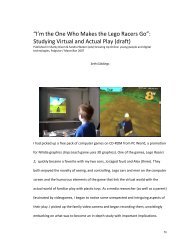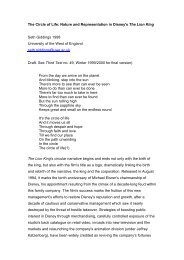Walkthrough: videogames and technocultural form - Seth Giddings
Walkthrough: videogames and technocultural form - Seth Giddings
Walkthrough: videogames and technocultural form - Seth Giddings
You also want an ePaper? Increase the reach of your titles
YUMPU automatically turns print PDFs into web optimized ePapers that Google loves.
the structuring binaries of Western thought, in particular the masculine subject as the agent of history. The<br />
notion of the posthuman, <strong>and</strong> science fictional figures of the matrix of cyberspace <strong>and</strong> the cyborg, are (more<br />
or less ironically) invoked. These theories have been influential on many studies of new media – particularly<br />
on critical cyberculture.<br />
Cultural Studies, Media Studies, <strong>and</strong> Cultural <strong>and</strong> Media Studies<br />
Critical cyberculture often operates within Cultural Studies. For example Aronowitz et al’s Technoscience<br />
<strong>and</strong> Cyberculture (1996), <strong>and</strong> Penley <strong>and</strong> Ross’s Technoculture (1991) address technology <strong>and</strong> technoscience<br />
from a Cultural Studies perspective. Within Cultural Studies, particularly in North America, there has been a<br />
sustained enquiry into the relationships between technology, science, medicine <strong>and</strong> culture. Again, Donna<br />
Haraway’s socialist <strong>and</strong> feminist articulations of science <strong>and</strong> technology have been highly influential, a<br />
springboard for much work on technoculture by feminists <strong>and</strong> other Cultural Studies scholars. Anne<br />
Balsamo acknowledges the significance of Haraway’s essay, but also charts a longer history of Cultural<br />
Studies <strong>and</strong> the study of science <strong>and</strong> technology (Balsamo 1998), including the work of Marshall McLuhan<br />
<strong>and</strong> Raymond Williams. She asserts the importance of these objects of study for Cultural Studies as ‘science,<br />
technology <strong>and</strong> medicine […] the dominant institutional sites for the production <strong>and</strong> circulation of<br />
contemporary global culture’ (Balsamo 1998: 285).<br />
Cultural Studies <strong>and</strong> Media Studies have their own disciplinary, institutional <strong>and</strong> conceptual<br />
genealogies but these are often tangled together. For example the widely used ‘Culture, Media <strong>and</strong> Identities’<br />
series of textbooks (e.g. Hall 1997, DuGay et al 1997, Mackay 1997, discussed in some detail in Part 3.1)<br />
indicate a certain normalisation of the overlap between Cultural Studies <strong>and</strong> Media Studies, as does – for<br />
example – the School within which I work <strong>and</strong> within which this research is undertaken. I will refer to these<br />
disciplines separately as far as possible to preserve clarity, but will also use ‘Cultural <strong>and</strong> Media Studies’<br />
when it is specifically the overlap between them that is being referred to. As this thesis takes as its focus the<br />
point of contact between the <strong>form</strong> <strong>and</strong> conventions of the <strong>videogames</strong> as media ‘text’ <strong>and</strong> the contexts <strong>and</strong><br />
events of its ‘consumption’ in everyday culture then this disciplinary overlap is significant.<br />
Within the UK disciplines related to Cultural Studies <strong>and</strong> Media Studies, primarily communication<br />
studies <strong>and</strong> media sociology have - when they are concerned with technology - often looked at the everyday<br />
11




